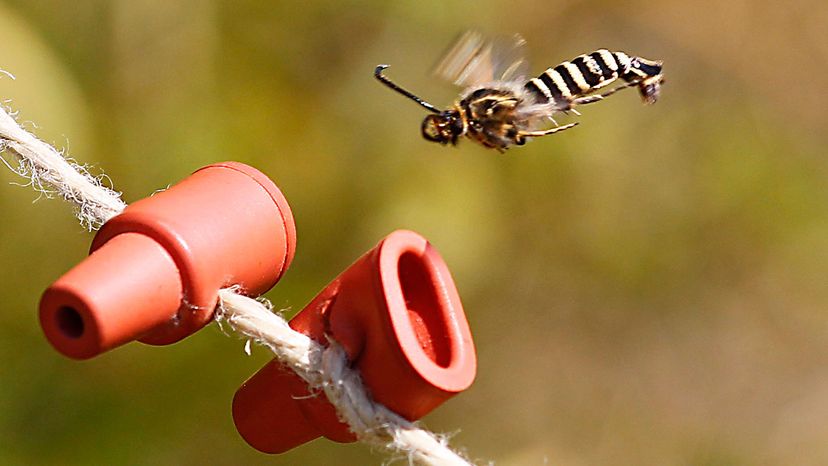
When they're ready to mate, silkworm moths emit special chemicals in hopes of drawing males to their location. Those chemicals are so powerful – and so magnetic – that male moths will travel up to 30 miles (48 kilometers) for a chance to mate, tracking the female with just a few precious molecules of her scent guiding his way. The intoxicating chemicals are called pheromones.
Pheromones are special chemicals produced and secreted by living creatures, in small amounts, for a variety of purposes. Organisms use them to signal something (danger, territory, readiness to mate and so on) to another member of their social group or species. Scientists have confirmed the importance of pheromones in the lifecycles of many creatures, from elephants to crustaceans, insects to fish.
Advertisement
In many ways, pheromones are like hormones that act outside of the body. In fact, they bore the name ectohormones before researchers Peter Karlson and Martin Lüscher proposed a new word in 1959, deriving the term "pheromone" from the Greek word pherein (to bear or transport) and hormone (to stimulate or excite). More simply put, it's a chemical way for creatures to transfer excitement from one to the other. Given the lengths that tiny moths will travel in response to just a tiny whiff of these chemicals, that excitement must be powerful indeed.
Pheromones produce two general categories of effects: releaser effects, which cause rapid behavioral changes, and primer effects, which prepare the body for a later behavioral change. Pheromones can also affect biological processes such as maturation [sources: Bryner].
What Good Are Pheromones?
Pheromones are found throughout the insect and vertebrate worlds, among crustaceans and even in plants. They play a particularly important role among certain social insects, such as ants and termites, which use a variety of pheromones to organize and direct the goings-on in their respective colonies. Even fungi, slime molds and algae use pheromones to attract one another for reproduction.
A few examples of pheromone uses include:
- Ants laying a trail of scent pheromones to lead other colony members to a food source
- Wounded minnows exuding a pheromone that causes the rest of the school to scatter
- Mother rabbits producing a pheromone that triggers suckling in their pups
- Insects releasing a pheromone into the air, signaling their readiness to copulate
- Queen bees giving off a pheromone that inhibits ovarian development in other bees, eliminating competition
Organisms may distribute pheromones via a variety of mechanisms, including spraying them into the surrounding air or water or distributing them via urine. The chemicals linger for varying periods of time depending on their use. Danger signals disperse quickly, lest the recipients of the signal become overwhelmed by them or overly accustomed to them. Sexual signals persist longer to allow mates to locate the sender, but this also increases the danger of unwanted attention from parasites and predators. Marking signals, such as those used by animals to stake out territory or by egg-laying insects to warn others to lay their eggs elsewhere, last longer still.
Pheromones can be a powerful means of controlling behavior. Entomologists use them as a lure for trapping insects that they intend to study. Pheromones can also be employed to control undesirable populations by disrupting mating behaviors, preventing egg-laying and in general, introducing confusion.
To study pheromones, scientists must perform what's called a bioassay, using an experiment that tests whether a particular smell molecule induces a specific reaction in another creature. In the past, these experiments were exceedingly difficult in part because many organisms, like insects, release such minute amounts of pheromones during their lifecycles. Thanks to technological improvements, such as gas chromatography linked to mass spectrometry, researchers can more easily identify and confirm certain pheromones and their effects [source: Wyatt].
Pheromones and Sex
Given the importance of pheromones in the animal kingdom, it's easy to wonder how often human beings fall under pheromones' powerful spells. Perhaps, speculate scientists, these invisible chemicals play a major role in the way we choose our sex partners and long-term mates.
In humans, though, even after decades of research, scientists have yet to locate a genuine chemical in men or women that really seems to activate sexual interest. That's perhaps odd, particularly when animals that share a lot of our DNA clearly rely heavily on chemicals for reproduction. In primates, for example, higher levels of fatty acids in vaginal secretions, called copulins, make some females more desirable to males. So far, studies have not shown the same kind convincing effect on human males [source: Burriss].
Other studies have circled around androstenone, a body odor that seems to be strongest in men. Some scientists suspect androstenone boosts mood in women and potentially makes them more receptive to sex. It's certainly true in pigs – females who smell androstenone prepare for mating. So far, though, no one's been able to prove that the same kind of effect occurs in humans. The same goes for two internally generated steroids, androstadienone and estratetraenol, which some people tout as powerful human sex attractants – they've never been proven to have repeatable, demonstrable effects on attractiveness [sources: Mosher, Wyatt].
Much of human pheromone research has – perhaps for obvious reasons – fixated on sex pheromones. But there are plenty of other avenues for science to explore. One study in France, for example, found that women's nipple secretions prompted suckling from any newborn, not just her own [sources: Wyatt, Hadhazy].
Science's inconclusiveness regarding "love" pheromones hasn't stopped endless companies from trying to capitalize on specially formulated perfumes and colognes that are marketed as a way for men and women to attract romantic interest. A quick Internet search reveals a plethora of pheromone-enhanced products, sometimes with price tags double that of well-reviewed scents that aren't impregnated with any extra-special attraction molecules. They don't work. And not to further dash your hopes, but even if researchers do someday find a human pheromone that's specific to sexual attraction, it's very unlikely to have the kind of potent draw that female moths use to entice mates [source: Greenfieldboyce].
It could be that humans simply don't emit (or react to) pheromones quite the same way that other creatures do. Perhaps the level of pheromones is so low that the objects of our desire don't have senses strong enough to detect our chemical interests. Or perhaps thousands of years of civilization and cultural cues – from religious shame to, well, laws – have conditioned us to respond less to our base instincts and more to those of organized societies.
And if you want to kill the buzz of romance instead of kindle it? Take up crying as a hobby. One study demonstrated that the scent of women's tears didn't elicit empathy in men – instead, it turned them off, perhaps because on a primal level they realized that sex was likely not in the cards anytime soon [source: Everts].
The takeaway is that there are clearly some widespread chemical interactions happening within the animal kingdom, inspiring a vast array of interactions between creatures. By studying these more in greater detail, perhaps researchers will eventually begin to piece together a pheromone puzzle that helps us make sense of our own chemically driven behaviors, too.
Advertisement


